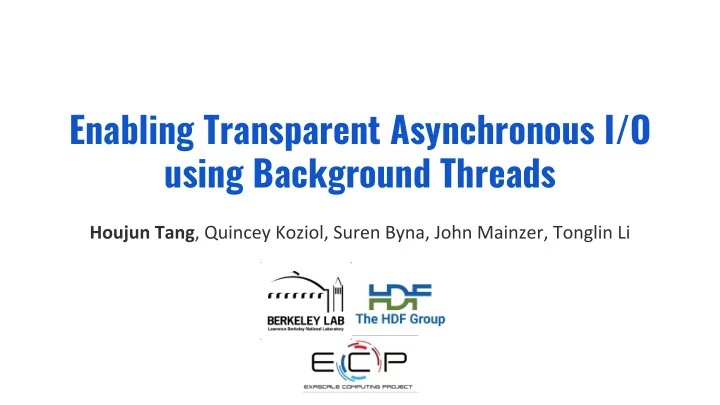

Enabling Transparent Asynchronous I/O using Background Threads
HPC I/O ● Synchronous ○ Code executes in sequence. ○ Computation is blocked by I/O, waste system resources. ● Asynchronous ○ Code may execute out of order. ○ I/O is non-blocking, can overlap with computation.
Synchronous vs. Asynchronous Sync Async
Existing Asynchronous I/O Solutions - POSIX I/O: aio_ * Limited number of low level - MPI-IO: MPI_File_i * asynchronous APIs - ADIOS/DataSpaces Requires extra server processes - PDC (Proactive Data Containers) Manual dependency management
Asynchronous I/O Design Goals ● Effective to execute all I/O operations asynchronously. ● Requires no additional resources (e.g. server processes). ● Automatic data dependency management. ● Minimal application code changes.
Implicit Background Thread Approach ● Transparent from the application, no major code changes. ● Execute I/O operations in the background thread. ○ Allow application to queue a number of operations. ○ Start execution when application is not busy issuing I/O requests. ● Lightweight and low overhead for all I/O operations. ● No need to launch and maintain extra server processes.
Dependency management Start Asynchronous I/O Initialization Start File Open App status check Create Obj No App Task Queue thread Write Obj idle? Yes Compute / Task File Close Execution Asynchronous I/O Finalize End End Application thread Background thread
Queue Management ● Regular task ● Dependent task ● Collective task
Dependency management ● File create/open execute first. ● File close waits for all existing tasks to finish. ● Any read/write operations execute after prior write to same object, in app’s order. ● Any write executes after prior reads of same object, in app’s order. ● Collective operations, in order, one at a time.
HDF5 Implementation ● VOL connector V irtual O bject L ayer ● HDF5 I/O operations ● HDF5 data model and API. ● Additional functions ● Switch I/O implementation. ● Background thread w/ Argobots Enable by: ● Environmental variable, or ● Error reporting ● H5Pset_vol_async()
HDF5 Implementation ● VOL connector Metadata operations ● HDF5 I/O operations ● Initiation : create, open. ● Modification : extend dimension. ● Additional functions ● Query : get datatype. ● Close : close the file. ● Background thread w/ Argobots Raw data operations ● Error reporting ● Read and write.
HDF5 Implementation ● VOL connector ● H5Pset_vol_async ● HDF5 I/O operations ● H5Pset_dxpl_async_cp_limit ● H5Dtest ● Additional functions ● H5Dwait ● ● Background thread w/ Argobots H5Ftest ● H5Fwait ● Error reporting
HDF5 Implementation ● VOL connector ● HDF5 I/O operations ● Additional functions ● Background thread w/ Argobots ● Error handling
Experimental Setup System Cori @ NERSC Single process Multiple process Benchmarks Workloads - Metadata heavy - Raw data heavy - Mixed I/O kernels VPIC-IO, time-series plasma physics particle data write BD-CATS-IO, time-series particle data read, analysis
Single Process - No Computation (Overhead) Overhead 5% average
Single Process - With Computation Speedup 2 - 9X
Multiple Process - Metadata Intensive Read Speedup 1.1 - 3.5X
Multiple Process - Metadata Intensive Write Speedup 1.1 - 2.1X
Multiple Process - VPIC-IO Speedup 5 - 7X
Multiple Process - BD-CATS-IO Speedup 5 - 9X
Conclusion ● An asynchronous I/O framework ○ Highly effective and low overhead. ○ Support all I/O operations. ○ Require no additional server processes. ○ Transparent from application. ● Future work ○ Apply this work to more applications and I/O libraries, further performance optimization. ○ “Event tokens” for explicit tracking and controlling the asynchronous I/O tasks.
Thanks! Questions?
Recommend
More recommend